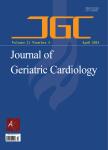Long-term outcomes after fractional flow reserve-guided percutaneous coronary intervention in patients with severe coronary stenosis
Long-term outcomes after fractional flow reserve-guided percutaneous coronary intervention in patients with severe coronary stenosis作者机构:Division of CardiologyXuanwu Hospital Capital Medical UniversityBeijingChina Division of Cardiovascular DiseasesMayo ClinicRochesterUSA Cardiovascular CenterCardiologyUniversity Hospital ZurichSwitzerland Department of Preventive Medicine College of MedicineKonyang UniversityDaejeonSouth Korea Biomedical StatisticsMayo ClinicRochesterUSA Division of Nephrology and HypertensionMayo ClinicRochesterUSA
出 版 物:《Journal of Geriatric Cardiology》 (老年心脏病学杂志(英文版))
年 卷 期:2019年第16卷第4期
页 面:329-337页
核心收录:
基 金:supported by the National Institute of Health (NIH Grant HL-92954 and AG-31750 to A.L) supported by an unrestricted grant from St Jude Medical supported by the National Natural Science Foundation of China (No.81470491) the Beijing Municipal Natural Science Foundation (No. 7192078)
主 题:Fractional flow reserve Outcome Percutaneous coronary intervention Severe stenosis Stent
摘 要:Objective To explore the safety and efficacy of FFR-guided percutaneous coronary intervention (PCI) in vessels with severe diameter stenosis. Methods & Results Of 1090 patients undergoing fractional flow reserve (FFR) assessment from 2002 to 2009,we identified 167 patients in whom FFR was measured in at least one 70%–89% stenotic lesion. These patients were subdivided into an FFR-defer group (n = 49) if PCI was deferred (FFR 0.80),and an FFR-perform group (n = 118) if PCI was performed (FFR ≤ 0.80). Comparatively,an additional 1176 patients undergoing PCI in at least one lesion with 70%–89% stenosis but without measurement of FFR served as a control (angiography- guided) group. Clinical outcomes were compared during a median follow-up of 49.0 months. The 5-year Kaplan-Meier estimated revascularization rates were 16% in the FFR-defer group and 33% in the FFR-perform group (P = 0.046). The incidence of major adverse cardiac events were comparable in these two groups (HR = 0.82,95% CI: 0.37–1.82,P = 0.63). The number of stents placed was significantly lower in the FFR-guided group (0.9 ± 0.8 vs. 1.4 ± 0.8,P 0.001). Conclusions Functional revascularization for lesions with visually severe stenosis is clinically safe and associated with fewer stents use. This study suggests that extending the use of FFR to more severe coronary lesions may be reasonable.



